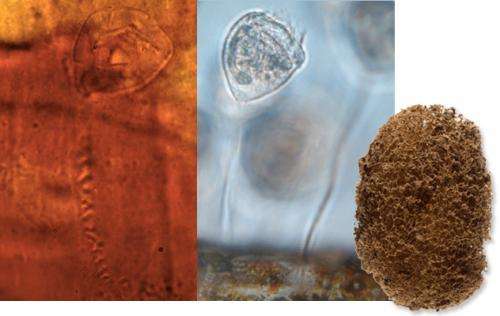December 4, 2012 report
Researchers find fossilized ciliate in 200 million year old leech cocoon

(Phys.org)—Palaeobiologists from the University of Kansas studying samples taken from the mountains of Antarctica have found a ciliate fossil embedded in the wall of a fossilized leech cocoon which was itself embedded in rock that has been dated back to 200 million years ago. The team outlines their findings in the Proceedings of the National Academy of Sciences.
The ciliate, a member of the Vorticella family, known more commonly as "bell animals" is a single celled protozoan that moves in water through the use of cilia that surround its body and appears to be very similar to many ciliates found today in fresh water ponds. Scientists believe that Antarctica was much warmer during the time when the fossil would have been alive due to the continent being located much farther from the South Pole and thus warm water ponds or streams could have existed where the fossil was discovered.
The specimen was found in rock samples taken from Timber Peak in the Eisenhower Mountain Range at an elevation of approximately 10,000 feet. To detect the fossilized ciliate, the researchers had to dissolve the rock using acid in a way that allowed preservation of the organic material (cocoon) inside. Studying the cocoons under a microscope revealed the presence of the microorganism.
Leeches cover themselves completely in a cocoon they create just prior to laying eggs. The eggs – still in the cocoon – are then deposited on nearby surfaces, such as rocks where they are cared for by the parent. In the case of the found fossil, the researchers believe the ciliate became stuck in the wall of the cocoon and then became fossilized as the cocoon itself did so.
The researchers describe the fossil as teardrop shaped with a horseshoe shaped main body. The find is especially intriguing because the ciliate is soft bodied which means it has no skeleton – because of that such finds are extremely rare. It also indicates that researchers have another avenue of research because now ancient leech cocoons may be considered as conservation traps – like amber – and thus other found specimens can be studied more closely to see if other organisms are preserved inside.
More information: Triassic leech cocoon from Antarctica contains fossil bell animal, PNAS, Published online before print December 3, 2012, doi: 10.1073/pnas.1218879109 . www.pnas.org/content/early/201 … /1218879109.abstract
Abstract
Our understanding of the evolution of life on Earth is limited by the imperfection of the fossil record. One reason for this imperfect record is that organisms without hard parts, such as bones, shells, and wood, have a very low potential to enter the fossil record. Occasionally, however, exceptional fossil deposits that preserve soft-bodied organisms provide a rare glimpse of the true biodiversity during past periods of Earth history. We here present an extraordinary find of a fossil ciliate that is encased inside the wall layer of a more than 200 Ma leech cocoon from Antarctica. The microfossil consists of a helically contractile stalk that attaches to a main body with a peristomial feeding apparatus and a large C-shaped macronucleus. It agrees in every aspect with the living bell animals, such as Vorticella. Vorticellids and similar peritrichs are vital constituents of aquatic ecosystems worldwide, but so far have lacked any fossil record. This discovery offers a glimpse of ancient soft-bodied protozoan biotas, and also highlights the potential of clitellate cocoons as microscopic "conservation traps" comparable to amber.
Journal information: Proceedings of the National Academy of Sciences
© 2012 Phys.org





















